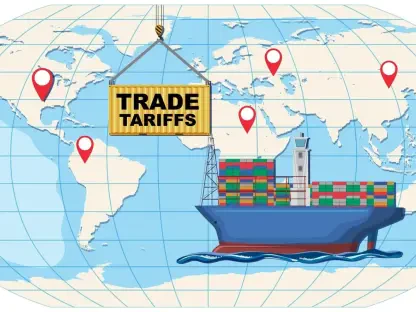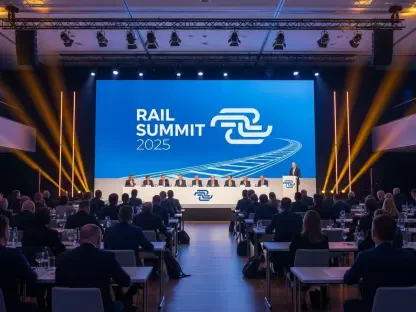The Rise of Cross-Border E-Commerce: A Global Phenomenon
Imagine a world where a consumer in a small European town can order a gadget from China and receive it within days, all for a fraction of the local retail price. This scenario, once a distant dream, is now a daily reality for millions, thanks to the explosive growth of cross-border e-commerce. This sector has emerged as a powerhouse of global trade, connecting markets and consumers across continents with unprecedented ease. Its rapid expansion has redefined how goods are bought and sold internationally, creating a seamless digital marketplace that prioritizes speed and affordability.
At the heart of this phenomenon lies the surge in low-value goods shipments, particularly from China to key markets like Europe and the United States. These shipments, often comprising electronics, clothing, and household items, have fueled a significant portion of the industry’s growth. Major players such as Alibaba, Amazon, eBay, Pinduoduo (through Temu), and Shein have been instrumental in this transformation, leveraging vast networks of sellers and innovative direct-to-consumer models to dominate the landscape. Their platforms have not only expanded access to affordable products but also reshaped consumer expectations for price and delivery speed.
Technology plays a pivotal role in sustaining this growth, with advanced logistics systems and streamlined supply chains enabling faster and cheaper deliveries. Direct-to-consumer approaches bypass traditional retail intermediaries, cutting costs and enhancing efficiency. However, regulatory factors, including international trade policies and customs processes, introduce complexities that can impact operations. From varying import duties to compliance with local standards, these elements pose challenges that even the largest platforms must navigate to maintain their global reach.
Growth Trends and Market Dynamics in Cross-Border E-Commerce
Key Drivers and Emerging Trends
The ascent of cross-border e-commerce is driven by several critical factors, chief among them being the consumer demand for low-cost goods. Shoppers are increasingly drawn to affordable alternatives, often sourced directly from manufacturers in regions like Asia. This trend is amplified by marketing strategies that promise luxury on a budget, with slogans like “shop like a billionaire” resonating deeply with a global audience seeking value without compromise.
Beyond affordability, evolving consumer behaviors are shaping the industry’s trajectory. Expectations for fast, often free shipping have become the norm, pushing platforms to prioritize speed in their delivery models. Technological advancements in logistics, such as optimized air cargo routes and automated warehousing, support this high-volume, low-cost paradigm, ensuring parcels move swiftly across borders. These innovations have become indispensable in meeting the heightened demands of today’s online shoppers.
Moreover, new opportunities are emerging as platforms expand into less saturated markets. Regions like Latin America and the Middle East present untapped potential, with growing internet penetration and a rising middle class eager for international products. Tapping into these areas offers a chance to diversify revenue streams, though it requires adapting to unique cultural and logistical challenges. This expansion signals a broader shift toward global inclusivity in e-commerce.
Market Data and Future Projections
Current data paints a striking picture of the industry’s scale, with air cargo volumes linked to e-commerce rising significantly in recent years. Estimates suggest that e-commerce now accounts for 25-30% of international air cargo, a substantial increase from just a few years prior. Specific routes, such as Asia-Pacific to Europe and the United States, have seen remarkable growth, with volumes climbing by nearly 50% and 40% respectively over a short span, underscoring the sector’s momentum.
Looking ahead, forecasts indicate that this upward trend in volume will persist, driven by increasing consumer reliance on online platforms for everyday purchases. However, profitability remains a pressing concern, as performance indicators reveal razor-thin margins for both e-commerce platforms and logistics providers. Many operate at minimal profit or even at a loss, relying on scale to offset costs rather than sustainable earnings.
This dichotomy between growth and financial returns casts a shadow over long-term projections. While transaction volumes are expected to rise steadily through 2027, experts caution that without strategic adjustments, the industry may struggle to convert this expansion into viable revenue. Balancing consumer appeal with economic stability will be crucial for stakeholders aiming to capitalize on future opportunities.
Financial and Logistical Challenges Threatening Sustainability
Despite the remarkable growth in cross-border e-commerce, persistent thin profit margins pose a significant threat to its sustainability. High transaction volumes have not translated into proportional earnings, as platforms often prioritize market share over profitability through aggressive pricing and subsidies. This approach, while effective in attracting customers, leaves little room for financial resilience, creating a precarious business model.
A useful parallel can be drawn with the airline industry, which has long grappled with low fares amidst high operational costs. Similarly, e-commerce platforms face escalating expenses in logistics and marketing, while air cargo providers struggle to manage surging parcel volumes at reduced rates. This pressure on both ends of the supply chain raises questions about the industry’s ability to sustain current growth rates without systemic changes.
Potential solutions include revising pricing strategies to reflect true costs or enhancing operational efficiencies through technology. Reducing reliance on subsidies could also help, though it risks alienating price-sensitive consumers. Without addressing these financial strains, there is a real risk of systemic collapse, which could manifest as slower delivery times, reduced product availability, or higher costs passed on to shoppers, ultimately undermining the sector’s appeal.
Regulatory and Compliance Landscape in Cross-Border Trade
Navigating the regulatory environment is a formidable challenge for cross-border e-commerce, as international trade agreements and customs regulations vary widely across regions. Import duties, taxes, and compliance requirements differ from one country to another, creating a complex web of obligations that platforms must manage. These inconsistencies can lead to delays or unexpected costs, impacting both profitability and customer satisfaction.
Security measures, such as data protection laws, add another layer of complexity. Ensuring compliance with regulations like the European Union’s GDPR or similar frameworks in other regions is critical for maintaining consumer trust and avoiding legal repercussions. Platforms must invest in robust systems to safeguard data, even as they scale operations to meet growing demand, balancing security with efficiency.
Regulatory changes can also directly influence shipping costs and delivery timelines, forcing businesses to adapt their models accordingly. For instance, stricter customs inspections or revised tariff structures could slow down parcel flows, while non-compliance risks penalties or market restrictions. Staying ahead of these evolving standards is essential for platforms to maintain their competitive edge and ensure uninterrupted access to global markets.
Future Outlook: Balancing Growth with Profitability
The trajectory of cross-border e-commerce suggests continued expansion, though financial constraints loom large over its future. As transaction volumes grow, platforms must find ways to translate this scale into sustainable earnings, potentially through innovative pricing or cost-cutting measures. Emerging technologies, such as AI-driven logistics optimization, offer promising avenues to enhance efficiency and reduce overheads, paving the way for a more balanced approach.
Market disruptors, including new entrants and alternative delivery models, could further reshape the landscape. Smaller, agile players may challenge established giants by focusing on niche markets or sustainable practices, while innovations in last-mile delivery could redefine speed and cost structures. These shifts underscore the dynamic nature of the industry, where adaptability will be key to staying relevant.
Consumer preferences are also evolving, with a growing emphasis on sustainability influencing purchasing decisions. Platforms may need to integrate eco-friendly practices, such as carbon-neutral shipping or ethical sourcing, to align with these values. Meanwhile, global economic conditions, including inflation and trade tensions, remain wildcard factors that could either hinder or accelerate growth, depending on how stakeholders respond to these external pressures.
Conclusion: Navigating the Path to Sustainable Success
Reflecting on the insights gathered, it becomes evident that cross-border e-commerce has achieved extraordinary growth, yet stands at a crossroads due to persistent profitability challenges. The paradox of booming transaction volumes alongside thin margins paints a cautionary picture for industry leaders who have driven this global phenomenon. Experts have consistently warned of potential instability, drawing sobering parallels with other high-volume, low-profit sectors, signaling that action is overdue.
Moving forward, stakeholders are urged to pivot toward sustainable pricing models that reflect true operational costs, reducing reliance on subsidies that mask deeper financial issues. Investment in efficient logistics, such as automated systems and optimized cargo routes, emerges as a critical step to bolster resilience. Collaboration among platforms, logistics providers, and regulators also stands out as a vital strategy to address systemic risks, ensuring that consumer appeal does not come at the expense of economic viability. Ultimately, the path to long-term success hinges on innovative solutions and a shared commitment to balance, setting a foundation for enduring growth in a competitive global market.









